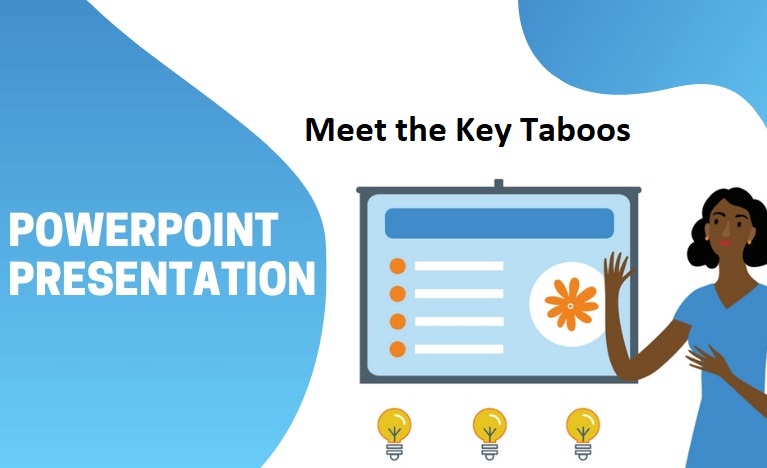Making a PowerPoint Presentation: Meet the Key Taboos
Five Things to Avoid in a PowerPoint Presentation
Constructing a PowerPoint presentation is not just informing your audience on a certain topic. It is more about educating your target audience and gaining their confidence in your knowledge of the issue under discussion.
Unfortunately, when it comes to making a presentation, a lot of students tend to make mistakes that lead to poor presentations and low grades. As a result, they have to approach online PowerPoint presentation writing services to help them with the projects. We have listed some of the most common mistakes that undergrads tend to make. If you ensure to avoid them in your works, you'll have the power to wow your target audience.
 Picture 1 of Making a PowerPoint Presentation: Meet the Key Taboos
Picture 1 of Making a PowerPoint Presentation: Meet the Key Taboos
#1 Talking to Your Presentation
There's one thing that all PowerPoint presentations have in common: you create them with your target viewers in mind. You did your best to create an attention-grabbing PowerPoint presentation, and you want to ensure that people are listening. It means you have to direct your attention not to the screen but to your target audience. A lot of presenters tend to look at the screen when they speak instead of focusing on their audience. It's no doubt you may find it hard to keep all information in your head. That is why there is nothing wrong with glancing at your slides from time to time to ensure that you stick to the plan. But make sure you don't look at your presentation all the time.
#2 You Include Too Much Text
When it comes to PowerPoint presentations, adding too much text on a slide is wrong. If you put an excessive amount of text, your viewers will find it hard to read and be discouraged to keep on viewing your work.
Keep in mind that your viewers are looking to see aesthetically-pleasing visuals that present what you're saying. They don't want to see the visuals that have nothing to do with your words or repeat what you've already said. To craft a winning PowerPoint presentation, ensure to use text for bullet points and titles primarily. Use wordy sentences only when you're 100% sure they're essential to help your audience understand the materials.
#3 Messy Slides
People tend to absorb information better if it is presented clearly and logically. If you include too many graphics and sentences, your target audience will become confused by what they see. As a result, they will lose their attention.
If too much is happening on your slides, you're going to lose your audience. That is why instead of cluttering your PowerPoint presentation with as many details as you can, choose simplicity. Make sure to include only the images and text and is important to support your message. Keep in mind that one powerful photo can do more to support your points than six average photos provided on a single slide.
#4 You Don't Practice
Neither Johnny Depp nor Kirsten Dunst gets in front of their audience without previous practice. When it comes to PowerPoint presentations, practice is equally important. Make sure to review your presentation more than once before you present it to your class. If you do so, it will help you feel more confident in front of your audience. Doing a range of practice runs will also help you detect all the mistakes that you made in your text and fix them.
#5 Using Inappropriate Information
The key purpose of your PowerPoint Presentation is to inform your audience. For that reason, you have to take into consideration the level of your viewers. Ensure to do some research on who is going to listen to you. Why are those people in front of you? Do they know anything about the topic you're presenting? If yes, how much do they know? What is it that they want to hear and learn from you? It's pointless to deliver a PowerPoint presentation that includes the terms that your viewers see for the first time in their life. If no one understands you, your presentation will turn into failure.
Before you create your PowerPoint presentation, do your best to put yourself in your viewers' shoes. Try to get a better idea about what motivates them and what is it that they need. Feel free to ask questions and greet your audience when you meet them. As a result, you will get a feel for what they already know. What is more, you will also personalize your work and connect with every viewer in a room. You'll be pleased to see how attentive your target audience will be.
Have you noticed any mistakes that you tend to make in your PowerPoint presentations? Now you know what college and university professors can't stand seeing in your academic works.
PowerPoint is an easy-to-use tool. However, when you're responsible for creating one, many things can go wrong. From mistakes that you can potentially make in slide creation to the jargon that you may use when you talk, there's a lot that could go down. Nonetheless, you can enhance your presentation making skills with practice that will boost your confidence as well.
Taking the tips given above, your next slideshow will flow better, be clear, and hook your target audience. After all, practice makes perfect. To prepare a winning presentation, make sure to take some extra time to find the most suitable template for your project. If possible, ensure to create your own template. While many built-in templates might look pretty generic, you will definitely be able to find the one that will look good combined with your content. It is recommended to stay away from any template that may look wacky and be multicolored. But make sure to give preference to something trendy and unique.
You should read it
- Review presentations in PowerPoint 2016
- 10 awesome PowerPoint templates make the presentation 'shine'
- 50 alternative slideshow applications for PowerPoint
- How to Add a PDF to a PowerPoint
- Rehearsal and record presentations in PowerPoint 2016
- Instructions for projecting PowerPoint 2010 files over the Internet
- How to Present a PowerPoint
- How to Loop in PowerPoint on PC or Mac
- Instructions for using Microsoft Power Point
- 4 effective PowerPoint slide templates for meetings
- MS PowerPoint 2007 - Lesson 3: Create a slideshow
- Tips for making a PowerPoint presentation for the classroom
May be interested

Summary of the most useful Excel keyboard shortcuts you should know

Steps to enable security features on Microsoft 365

How to Edit a PDF File on Windows

How to crop pictures in OneNote app?

How to align in Office Word standard paper size

Launch Microsoft PowerPoint from Command Prompt: complicated but useful






 Create beautiful slides for PowerPoint presentations with 8 tips
Create beautiful slides for PowerPoint presentations with 8 tips Tips for making a PowerPoint presentation for the classroom
Tips for making a PowerPoint presentation for the classroom Review presentations in PowerPoint 2016
Review presentations in PowerPoint 2016 How to Present a PowerPoint
How to Present a PowerPoint How to Add a PDF to a PowerPoint
How to Add a PDF to a PowerPoint Rehearsal and record presentations in PowerPoint 2016
Rehearsal and record presentations in PowerPoint 2016